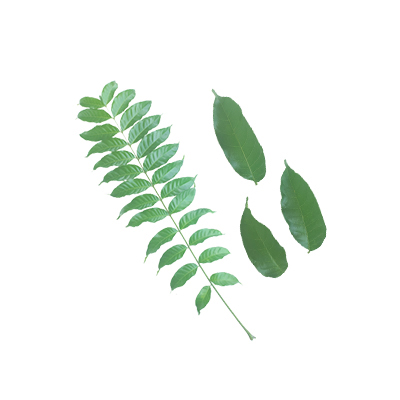Giant Neem Tree
Azadirachta excelsa (Jack) Jacobs
Meliaceae
Location in our garden
Principal



Synonym
Azadirachta integrifoliola Merr.
Azedarach excelsa (Jack) Kuntze
Melia excelsa Jack
Habitus
Trees. A large deciduous tree, growing up to 50 m tall
Part Used
Seeds
Flowers
Young Shoot
Growing Requirements
Full Sunshine
Habitat
Forest
Roadside
Overview
Native to the Philippines, Malaysia, Borneo, Indonesia, Vietnam, Papua New Guinea. A multipurpose tree with edible and medicinal uses, as well as a host of other applications such as oil, agroforestry, insecticide and timber. It is harvested from the wild, mainly for local use, but the timber is traded. A beautiful tree, it has been planted along the sides of roads, in botanical and experimental gardens.
Vernacular Names
Sentang (Malay), Sa-dao-thiam (Thai), Maranggo (Philippines), Azadirachta (Papua New Guinea).
Agroecology
A plant of lowland monsoonal areas in the tropics, where it grows at elevations up to 350 m. It is found in areas where the mean annual rainfall is in the range 2,000 - 4,000 mm, and the mean annual temperature is 22 - 27°c. Prefers alluvial, medium textured, free draining, acidic soils. It is also found growing on clay soils, granite soils; lateritic soils and limestone. Prefers a pH in the range 5 - 6.5. Plants are intolerant of waterlogging or frequent flooding.
Morphology
- Stems - without branches up to 20 m high, circumference can reach 12.5 m wide, bark smooth when young and becomes cracked in older trees.
- Leaves - green, alternately arranged, about 30 - 60 cm long, each leaf has about 7 - 11 pairs of lanceolate to elliptical leaflets measuring about 12.5 cm long and 3.5 cm wide.
- Flowers - fragrant, greenish white, grows in the axils of the panicles up to 70 cm long, each flower measuring about 0.5 - 0.65 cm long and 0.15 - 0.25 cm wide, 5 petals.
- Fruits - oval shaped, about 2.4 - 3.2 cm long, changes color from green to yellow when ripe, contains 1 seed.
Cultivation
- Propagated by seeds - Stored seed quickly loses its viability. The seeds germinate in 6 - 23 days. Direct dibbling of seeds into a prepared container to the same depth as the seed dimension (about 1 cm deep) and covering with soil is the recommended sowing method. When seedlings reach 30 - 40 cm tall (usually in 3 or 4 months), they are ready for outplanting.
- By root cuttings - Over 90% rooting rates have been obtained when cuttings are taken from coppicing shoots. Rootlets 0.3 - 0.5 cm diameter and 3 - 5 cm long have been used successfully as propagules.
Chemical Constituents
Flavonoid compounds, condensed tannins, terpenes, and steroids, 9,12,15-octadecatrenoic acid; pentadecanoic acid; 14-methyl-,methyl ester; phytol; 9,12,15-octadecatrueb-1-ol; octadecanoic acid, methyl ester; 8,12-octadecadienoic acid, methyl ester; and hexadecanoic acid, methyl ester. Four meliacin-type limonoids: 2,3-dihydronimbolide, 3-deoxymethylnimbidate, nimbolide, and 28-deoxonimbolide. Fatty acids are caprylic acid, n-capric acid, palmitic acid, stearic acid, heneikosanoic acid, behenic acid, and tricosanoic acid.
Traditional Medicinal Uses
- Malays used the plant to lower blood glucose.
- Used for treatment of diarrhea and dysentery.
- Young shoots and flowers used for stomach and nasal problems.
- Seed oil used in traditional medicine for treatment of diabetes, antibacterial, wound healing and as antifertility medicine.
Part Used
Reference Sources
- Royal Botanic Gardens. Plants of the World Online: Azadirachta excelsa (Jack) Jacobs. https://powo.science.kew.org/taxon/urn:lsid:ipni.org:names:577602-1#synonyms. 17-05-22.
- Tropical Plants Database, Kern Fern. 2021. Azadirachta excelsa. https://tropical.theferns.info/viewtropical.php?id=Azadirachta+excelsa. 17-05-22.
- Flora Fauna Web. 2021. Azadirachta excelsa. https://www.nparks.gov.sg/florafaunaweb/flora/2/7/2737. 17-05-22.
- Stuartxchange. 2021. Philipphine Medicinal Plants: Marrango Azadirachta excelsa (Jack) Jacobs.. 13-05-2022. http://www.stuartxchange.org/Marrango.
- PROSEA. Azadirachta A.H.L. Juss.. 13-05-2022. https://www.prota4u.org/prosea/view.aspx?id=27.
